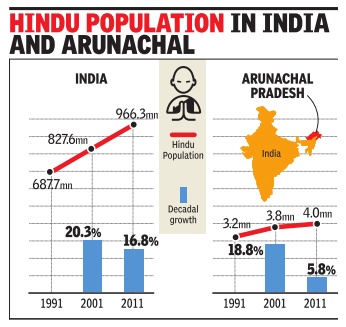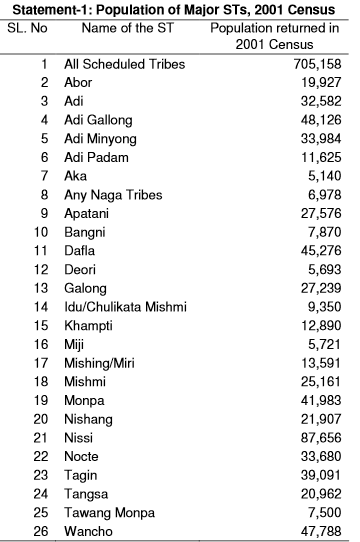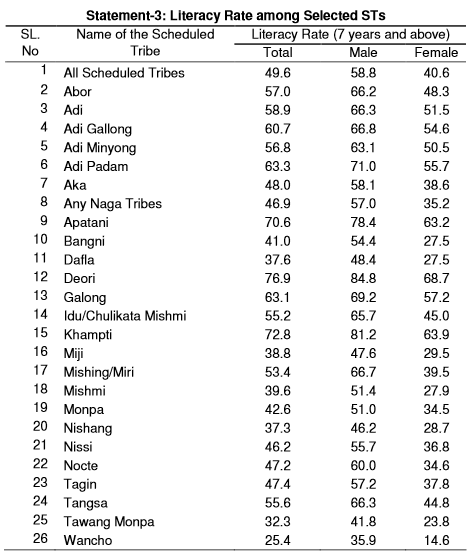Arunachal Pradesh (home page)
(→2015: Arunachal Pradesh opposes Indian citizenship) |
(→AREA, POPULATION AND HEADQUARTERS OF DISTRICTS) |
||
| Line 122: | Line 122: | ||
13. Tirap 2,362 1,00,326 Khonsa | 13. Tirap 2,362 1,00,326 Khonsa | ||
| + | |||
| + | ==Population by religion== | ||
| + | ===2011 census=== | ||
| + | [http://epaperbeta.timesofindia.com//Article.aspx?eid=31808&articlexml=Conversion-tweet-lands-Kiren-Rijiju-in-a-tough-14022017018030 Cong: A Bid To Polarise Voters In UP, Feb 14, 2017: The Times of India] | ||
| + | |||
| + | [[File: Hindu population in Arunachal Pradesh and India.jpg|Hindu population in Arunachal Pradesh and India; [http://epaperbeta.timesofindia.com//Article.aspx?eid=31808&articlexml=Conversion-tweet-lands-Kiren-Rijiju-in-a-tough-14022017018030 Cong: A Bid To Polarise Voters In UP, Feb 14, 2017: The Times of India]|frame|500px]] | ||
| + | |||
| + | |||
| + | As per the Census 2011, Christians in Arunachal Pradesh grew from 18.7% of the total population in 2001to become the most dominant religious group at 30.26%.Hindus declined from 34.6% of the population to 29.04%, and are no longer the largest religious group in the state.Those following other faiths, mostly indigenous, were also lower at 26.2% in 2011compared to 30.7% 10 years ago. | ||
=Wildlife parks and sanctuaries: India= | =Wildlife parks and sanctuaries: India= | ||
Revision as of 21:27, 13 March 2017
This is a collection of articles archived for the excellence of their content. Readers will be able to edit existing articles and post new articles directly |
Contents |
The source of this article
INDIA 2012
A REFERENCE ANNUAL
Compiled by
RESEARCH, REFERENCE AND TRAINING DIVISION
PUBLICATIONS DIVISION
MINISTRY OF INFORMATION AND BROADCASTING
GOVERNMENT OF INDIA
Arunachal Pradesh
Area : 83,743 sq km Population : 10,97,968 (as per 2001 census); 13.82 lakh (as per prov. census 2011)
Capital : Itanagar
Major Tribes : Monpa, Miji, Aka, Sherdukpen, Nyishi, Apatani, Tagin, Hill Miri, Adi, Digaru- Mismi, Idu-Mishmi, Khamti, Miju- Mishmi, Nocte, Tangsa and Wancho.
HISTORY AND GEOGRAPHY
Arunachal Pradesh became a full-fledged State on 20 February 1987. Till 1972, it was known as the North-East Frontier Agency (NEFA). It gained the Union Territory status on 20 January 1972 and renamed as Arunachal Pradesh. On 15 August 1975 an elected Legislative Assembly was constituted and the first Council of Ministers assumed office. The first general election to the Assembly was held in February 1978.
Administratively, the State is divided into sixteen districts. Capital of the State is Itanagar in Papum Para district. Itanagar is named after Ita fort meaning fort of bricks, built in 14th century AD.
Arunachal Pradesh finds mention in the literature of Kalika Purana and Mahabharata. This place is the Prabhu Mountains of the Puranas.
It was here that sage Parashuram atoned for his sin, sage Vyasa meditated, King Bismaka founded his kingdom and Lord Krishna married his Consort Rukmini. The widely scattered archaeological remains at different places in Arunachal Pradesh bear testimony to its rich cultural heritage.
AGRICULTURE AND HORTICULTURE
Agriculture is the mainstay of the people of Arunachal Pradesh and mainly depends on jhum cultivation. Encouragement is being given to the cultivation of cash crops like potatoes and horticulture crops like apples, oranges and pineapples.
INDUSTRIES AND MINERALS
For conservation and exploration of the vast minerals the Arunachal Pradesh Mineral Development and Trading Corporation Limited (APMDTCL) was set up in 1991. Namchik-Namphuk coal fields are taken up by APMDTCL. To provide training to craftsmen in different trades there are two Industrial Training Institutes at Roing and Daporijo.
FESTIVALS
Some of the important festivals of the State are: Mopin and Solung of the Adis, Lossar of the Monpas, Boori-boot of the Hill Miris, Sherdukpens, Dree of the Apatanis, Si-Donyi of the Tagins, Reh of the ldu-Mishmis, Nyokum of the Nishis, etc. Animal sacrifice is a common ritual in most festivals.
TOURIST CENTRES
Places of tourist interest are : Tawang, Dirang, Bomdila, Tipi, Itanagar Malinithan, Likabali, Pasighat, Along, Tezu, Miao, Roing, Daporijo Namdapha, Bhismaknagar, Parashuram Kund and Khonsa.
PANCHAYATI RAJ
The Arunachal Pradesh State Election Commission in support of State Government has sucessfully conducted and completed Panchayati Raj Elections in the State in the month of May 2008 for speedy development in the village and grass root level.
GOVERNMENT
Governor : General (Retd.) J.J. Singh Chief Secretary : Shri Tabom Bam Chief Minister : Shri Nobam Tuki
Jurisdiction of High Court: Falls under Guwahati
AREA, POPULATION AND HEADQUARTERS OF DISTRICTS
S .No. District Area (sq km) Population Headquarters
(Census 2001)
1 Tawang 2,172 38,924 Tawang
2. West Kameng 7,422 74,599 Bomdila
3. East Kameng 4,134 57,179 Seppa
4. Papum-Pare 2,875 1,22,003 Yupia
5. Lower Subansiri 10,135 98,244 Ziro and Kurung Kumey
6. Upper Subansiri 7,032 55,346 Daporijo
7. West Siang 8,325 1,03,918 Along
8. East Siang 4,005 89,397 Pasighat
9. Upper Siang 6,188 33,363 Yingkiong
10. Dibang and 13,029 57,720 Anini Lower Dibang Valley
11. Lohit and Anjaw 11,402 1,43,527 Tezu
12. Changlang 4,662 1,25,422 Changlang
13. Tirap 2,362 1,00,326 Khonsa
Population by religion
2011 census
Cong: A Bid To Polarise Voters In UP, Feb 14, 2017: The Times of India

As per the Census 2011, Christians in Arunachal Pradesh grew from 18.7% of the total population in 2001to become the most dominant religious group at 30.26%.Hindus declined from 34.6% of the population to 29.04%, and are no longer the largest religious group in the state.Those following other faiths, mostly indigenous, were also lower at 26.2% in 2011compared to 30.7% 10 years ago.
Wildlife parks and sanctuaries: India
NAMDAPHA NATIONAL PARK
Namdapha with its unique geographic location (a meeting point of different zoo-geographic ones) and varied altitudes is an ideal home for a diversity of life. It is well spread out with heights ranging from 200 mt. to 4500 mt. At lower heights one can find wet evergreen forests; in the middle level, deciduous forests; and at higher elevations, one can see conifers and alpine forests. Namdapha is nature's bounty both for a botanist and a zoologist. This area, till date, has not been studied completely and the possibilities of new discoveries are always there. It is also the eastern most refuge for the Indian Tiger. The Sanctuary also sustains two other big cats, the Clouded leopard and the leopard.
Location
Margherita (62 km)
Access 180.7 sq. Kms
Best season to visit: October to March
Access
By Air - Dibrugarh (163 km) By Rail - Ledo (56 km)
Accommodation
Government Tourist Lodge Miao, Rest House at Namchik
Contact
Field Director, Project Tiger, P.O. Miao, Distt. Tirap, Arunachal Pradesh
Arunachal Pradesh: The Scheduled Tribes Census of India 2001
The total population of Arunachal Pradesh in 2001 Cen sus has been 1,097,968. Of these 705,158 persons are Scheduled Tribes (STs), const ituting 64.2 per cent of the total population. The state has registered a decadal g rowth of 28.1 per cent of ST population in 1991-2001 Census.
2.The list of STs in Arunachal Pradesh is open in nature. According to the Scheduled Castes and Scheduled Tribes Lists (Modification) Order, 1956 and as inserted by Act 69 of 1986 states, the STs in the state a re “All tribes of the State including: Abor, Aka, Apatani, Dafla, Galong, Khampt i, Khowa, Mishmi, Monpa, Momba, Any Naga tribes, Sherdukpen, Singpho”. The notificat ion gives only an illustration of a few STs. In 2001 Census, total of 100 STs have been enu merated. Twenty-five of them have returned 5,000 and above population (Statement-1).
Population: Size & Distribution
3.District wise, Lower Subansiri, Upper Subansiri, East K ameng, Tirap, and West Siang are predominantly ST districts with the proport ion of ST population 80 per cent and above. These districts together share half of the t otal ST population of the state (Statement-2).
4.The STs in Arunachal Pradesh are predominantly living in rural areas (86 per cent). Individual ST wise, Wanchos have returned 2.3 pe r cent urban population. The percentage of urban population is less than five per cen t among several of the Tangsa tribes. However, Apatani has returned 51.4 per cent urban population.
Sex Ratio
5.Arunachal Pradesh has recorded more females in the pop ulation with sex ratio of 1003. In contrary to this overall situation, Any Nag a Tribes have recorded a low sex ratio of 887.
6.The child sex ratio (0-6 years) of 976 for STs is hig her than the aggregated national figure (973) for the same category. Deori ha ve recorded a low sex ratio of 906. The child sex ratio of above 1000 has been recorded amo ng Apatani, Bangni, Dafla, Tawang Monpa, Nissi, and Tangsa.
Literacy & Educational Level
7.Among STs, 49.6 per cent of the population has be en returned as literate, which is just below the national average (47.1 per cent). As many as thirteen STs have overall literacy level below 50 per cent .While male literacy is at 58.8 per cent, female literacy is only 40.6 per cent. The female literacy is depressed as se venteen STs have recorded literacy below 50 per cent. At the individual level, D eori, Khampti, and Apatani have recorded literacy rate of 70 per cent and above, while for Wancho it is low at 25.4 per cent. The lowest literacy level for both male and fem ale have been noted among the Wancho with male and female literacy rate of 35.9 per cent and 14.6 per cent respectively (Statement-3).
8.Among STs, 56.4 per cent of the children in the age group 5-14 years are attending schools or any other educational institutions. Apatani have recorded a high of 86.1 per cent and Wancho a low of only 31.2 per cent o f their population of this age group attending educational institutions. Besides Apatan i, the Deori, Khampti, and Adi Padam have recorded student population of 70 per cent and above of this stipulated age category.
9.Among ST literates, 3.5 per cent are having educatio nal level graduation and above. The Abor, Adi, Apatani, and Adi Padam have r ecorded more than 5 per cent of their literates having this status. Wancho, Aka, Bangni , Miji, and Nocte are quite lagging behind in higher education having the percentage of t he total literates having educational level graduation and above of just around one per cent.
Work Participation Rate (WPR)
10.The percentage of workers to total population (WPR) among the STs is 43 per cent. The female WPR at 41.2 per cent is just lower th an male (44.8 per cent). Of the total workers, the main and marginal workers are 84.4 per cent and 15.6 per cent respectively. Like male workers (88.8 per cent), a larg proportion of females (79.7 per cent) have also been returned as main workers (State ment-4).
Category of Workers
11.An overwhelming 75.1 per cent of the ST main work ers have been registered as cultivators and merely 1.1 per cent as agricultural labourers.
12.Individual ST wise, Wancho (91.3 per cent), Mishmi ( 87.1 per cent), Nocte (83.7 per cent), Dafla (83.4 per cent), Miji (82.3 pe r cent), Tangsa (82.1 per cent), and Adi Minyong (80.2 per cent) have recorded more than 80 per cent of their main workers as cultivators. It is, however, interesting that Apata ni – the famous terrace cultivators of Arunachal Pradesh – have registered only 39.1 per cent cultivators.
Marital Status
13.As regards marital status, 58.4 per cent of the ST p opulation is never married, 37.3 per cent currently married, 3.8 per cent widowed, and 0.5 per cent divorced & separated.
14.Among STs, 1.5 per cent of the females below 18 yea rs – the minimum legal age for marriage - have been registered as ever marri ed. The highest 2.5 per cent ever.
married females of this stipulated age have been regi stered among Nishang. This percentage is low among Nocte (0.6 per cent), Wancho (0 .5 per cent), Khampti (0.7 per cent), Idu/Chulikata Mishmi (0.8 per cent), Tangsa (0.9 per cent), and Mishmi (0.8 per cent).
15.The ever married males below 21 years – the minimu m legal age for their marriage – constitute 1.8 per cent. The ever married males of this stipulated age among Nishang constitute a high of three per cent, which is hi gher than the state average for all STs.
Religion
16.Of the total ST population, 47.2 per cent has been returned under the category of “Other Religion Followers”. Besides, 26.5 p er cent of the STs are Christians, 13.1 per cent Hindus, and 11.7 per cent Budhists. In Aru nachal Pradesh, unlike Nagaland, Mizoram, and Manipur, considerable ST popul ation are still adhering to original tribal faith. Individual ST wise, Khampti, Monpa, Momba, Sherdukpen, and Singpho are mostly the followers of Buddhism, while q uite sizeable population among Adi, Nishi, Nocte, and Wancho have been converted to Ch ristianity.
Chakma, Hajong refugees
2015: Arunachal Pradesh opposes Indian citizenship
The Times of India, Oct 27 2015
Chakmas, Hajongs can't get Indian citizenship
The Arunachal Pradesh government told the Supreme Court that Chakmas and Hajong refugees who migrated to India from Bangladesh in 1964-69 and settled in the state cannot be granted Indian citizenship. In a review petition filed in the Supreme Court, the state government pleaded the court to re-examine its verdict directing it and the Centre to grant citizenship to the refugees within three months. It said the SC erred in passing order without hearing the state government. “Out of total 4637 applications, 4213 applications for citizenship do not fulfil the criteria of signing of oath of allegiance, as per the second schedule to the Citizenship Act, 1955 and police verification of character and antecedents required re-verification.The verification had to be done for only those Chakma-Hajongs who were accommodated between 1964-1969. These relevant aspects have not been considered at all and there are errors apparent in the judgment,“ the petition said.
The apex court in September 2015 said Chakmas had a right to be granted citizenship and they could not be discriminated against in any manner. It directed the government to take all necessary steps to protect them as they are facing hostility from the local population.



